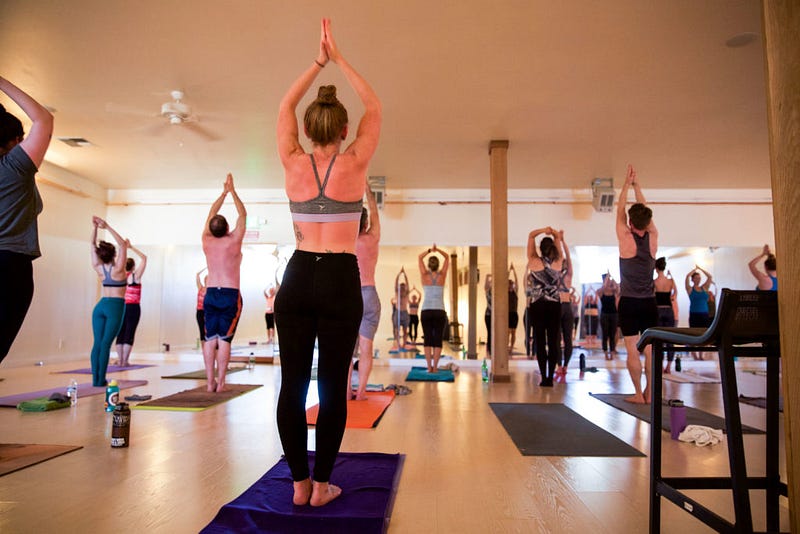105 degrees Fahrenheit
The intensity of hot yoga offers healing for injury and stress
STORY BY KYLEE MORGAN | PHOTOS BY BEATRICE HARPER
(Above) Sara Hawn directs a Hatha yoga class in April at Elements Hot Yoga Studio. Yoga helps protect your body from injury and can also help improve athletic ability through toning the muscles and increasing flexibility.
In a scalding room, beads of sweat ball up on shoulders, trickling down ankles and soaking backs, falling from everyone’s face like tear drops.
A comfortable 80 degrees earlier in the day, the cream painted room has transformed into what seems like a furnace. About 45 degrees warmer than the Bellingham air, 105 degrees Fahrenheit begins to melt everyone away.
This is the beginning of a Hatha yoga session, one of the classes offered at Elements Hot Yoga Studio in Bellingham, Washington. Hatha yoga which was inspired by Bikram yoga or the original hot yoga, typically lasts 60 to 90 minutes and consists of 26 poses and two breathing exercises.
For Sara Hawn, owner of Elements Hot Yoga Studio, which she started in 2013, hot yoga has helped with physical injuries and stress.
Hawn walks into the room. With wavy brown hair, blue eyes and a sailor’s mouth ready to unveil her bold personality. She turns on Joan Jett, one of her many classic rock playlists she teaches class to and greets each individual student by name, quickly learning the names of new students.
She saunters over to her own organic, natural rubber mat, which she explains has been harvested from rubber trees for earth-friendly purposes as well as having health benefits from the lack of chemical additives found in regular yoga mats.
Hawn turned to yoga for healing at age 15, describing herself as a sickly child who struggled with asthma, snowboarding injuries and mental stress.
“There’s something unique about hot yoga in that heated room,” Hawn says. “If you have a part of your body that’s tight, and you’re able to heat it up so it’s able to stretch more freely, it increases blood flow and releases detoxifying sweat.”
The benefits of hot yoga compared to classic yoga are based on the theory that warm muscles are more receptive to movement, allowing for deeper opening through each posture and fewer tendencies toward injury, Katie L. Chapman says in the Health and Fitness Journal of Canada.
Through the liquefying of the fascia, a connective tissue in the body and the heating of the core body temperature, hot yoga is intense but beneficial for the body.
Yoga has been know to reduce stress, lower heart rate and blood pressure and improve overall psychical fitness the National Center for Complementary and Integrative Health says.
Hawn thought her first time doing hot yoga was the worst experience of her life. She was sweating; felt like she was suffocating and she hated her teacher.
After swearing to never step foot in to hot yoga again, Hawn noticed that her health issues began to reappear. She decided to give it another go when she saw how yoga was helping her mother with her asthma. For eight months she forced herself into the studio almost everyday until her health began to improve.

“In those eight months, my knees healed completely to the point where I could snowboard again,” she says. “I was off all my asthma medication, my lymph nodes went down. I completely got my health back.”
On the opposite side of the spectrum, Western student Vivian Boggs, stuck to her word about never returning to the 105 degree temperature room.
While there are benefits of practicing hot yoga, there is also a potential for heat intolerance among some students, according to American Council of Exercise Fitness. Heat intolerance or exhaustion symptoms can include headaches, dizziness, weakness, profuse sweating and an elevated core body temperature.
“You’re in there for 10 seconds, you’re already sweating and you have to accept the fact that you will be sweating,” Boggs says. “I felt like I wasn’t getting any oxygen what so ever, every time I stood up I felt like I was going to pass out.”
Boggs explains how she thinks that the lack of hydration was a key factor to why her body reacted so poorly. She had decided to take a class at Hot Yoga Inc. in Mill Creek, Washington during the peak of July, when the weather was already warmer than usual. Ten minutes into the class she began to feel sick and laid down on her mat. Ignoring the encouragements of her instructor to try the pose, Boggs focused on fighting nausea and wooziness.
Water, electrolytes and food are necessary after a session, Hawn says. But they are just as important before and during a session, according to Ace Fitness.
Before a class, Hawn encourages students to arrive hydrated, about 20 minutes early to acclimate to the heat dressed in light, comfortable clothing. She also adds to avoid eating for at least two hours before class to avoid nausea.
Humidity continues to pump into the room, clothing clinging to bodies as sweat drenches them. There are only a few more asanas left before it’s time to say “Namaste.” Regulars keep up with Hawn as she bends into the next pose while new students are still adjusting to the heat.
Cool air crashes into the students like a wave as they begin to file out of the 105-degree room. Even in July, the outside temperature feels significantly cooler than the heat of Elements Hot Yoga Studio.
